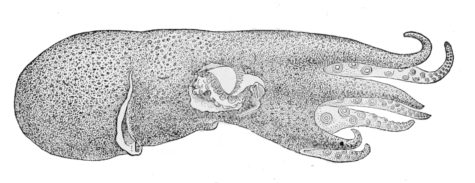I’ve written about cephalopod penises before, but the time seems right to approach this subject (with extreme caution) again. You know, because it’s Friday.

The octopus and the number eight seem inseparable. We have read children’s counting books that feature this cephalopod prominently between pages 7 and 9; we flip through under-the-sea books that rhyme “eight” with “great!” and carefully point out each of the felt legs. (Side note: why are the octopuses in our books always purple?) When we visit our local aquarium, we dutifully inspect that the resident octopus has all of its appendages intact.
Then I saw this video. Go ahead, count how many tentacles the octopus has.
Ok, it’s the cephalopod equivalent of a photobomb, so I can’t really count them very accurately. But this is the unusual Haliphron atlanticus–aka the seven-arm octopus–one of the largest octopus species in the world.
Something seems wrong about this, doesn’t it? Seven arms. Very, very wrong.
I’ve since learned that this species actually does have eight tentacles. But the male of the species can tuck up its “mating arm,” or hectocotylus, in a convenient little pouch by its eye.
This species is fascinating for other reasons—it’s enormous, for one. It can grow to 11 feet long or more, rivaling the massive giant Pacific octopus. It seems to live along ocean floor and the deepest underwater slopes—but has also been found in the open ocean, miles from either of these spots.
And that hectocotylus? It detaches. (Earworm warning: It detaches.)
What would the world be like if more species had this feature? It certainly would be interesting. On second thought, maybe it would just be more of the same.
**
Image: – The cephalopods of the northeastern coast of America, via Wikimedia Commons